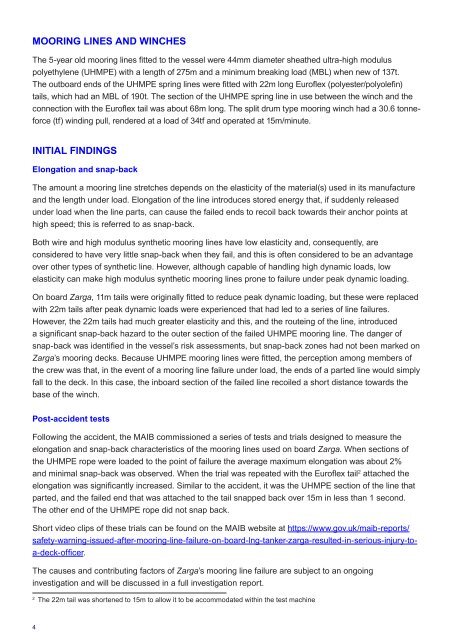You also want an ePaper? Increase the reach of your titles
YUMPU automatically turns print PDFs into web optimized ePapers that Google loves.
MOORING LINES AND WINCHES<br />
The 5-year old mooring lines fitted to the vessel were 44mm diameter sheathed ultra-high modulus<br />
polyethylene (UHMPE) with a length of 275m and a minimum breaking load (MBL) when new of 137t.<br />
The outboard ends of the UHMPE spring lines were fitted with 22m long Euroflex (polyester/polyolefin)<br />
tails, which had an MBL of 190t. The section of the UHMPE spring line in use between the winch and the<br />
connection with the Euroflex tail was about 68m long. The split drum type mooring winch had a 30.6 tonneforce<br />
(tf) winding pull, rendered at a load of 34tf and operated at 15m/minute.<br />
INITIAL FINDINGS<br />
Elongation and snap-back<br />
The amount a mooring line stretches depends on the elasticity of the material(s) used in its manufacture<br />
and the length under load. Elongation of the line introduces stored energy that, if suddenly released<br />
under load when the line parts, can cause the failed ends to recoil back towards their anchor points at<br />
high speed; this is referred to as snap-back.<br />
Both wire and high modulus synthetic mooring lines have low elasticity and, consequently, are<br />
considered to have very little snap-back when they fail, and this is often considered to be an advantage<br />
over other types of synthetic line. However, although capable of handling high dynamic loads, low<br />
elasticity can make high modulus synthetic mooring lines prone to failure under peak dynamic loading.<br />
On board Zarga, 11m tails were originally fitted to reduce peak dynamic loading, but these were replaced<br />
with 22m tails after peak dynamic loads were experienced that had led to a series of line failures.<br />
However, the 22m tails had much greater elasticity and this, and the routeing of the line, introduced<br />
a significant snap-back hazard to the outer section of the failed UHMPE mooring line. The danger of<br />
snap-back was identified in the vessel’s risk assessments, but snap-back zones had not been marked on<br />
Zarga’s mooring decks. Because UHMPE mooring lines were fitted, the perception among members of<br />
the crew was that, in the event of a mooring line failure under load, the ends of a parted line would simply<br />
fall to the deck. In this case, the inboard section of the failed line recoiled a short distance towards the<br />
base of the winch.<br />
Post-accident tests<br />
Following the accident, the <strong>MAIB</strong> commissioned a series of tests and trials designed to measure the<br />
elongation and snap-back characteristics of the mooring lines used on board Zarga. When sections of<br />
the UHMPE rope were loaded to the point of failure the average maximum elongation was about 2%<br />
and minimal snap-back was observed. When the trial was repeated with the Euroflex tail 2 attached the<br />
elongation was significantly increased. Similar to the accident, it was the UHMPE section of the line that<br />
parted, and the failed end that was attached to the tail snapped back over 15m in less than 1 second.<br />
The other end of the UHMPE rope did not snap back.<br />
Short video clips of these trials can be found on the <strong>MAIB</strong> website at https://www.gov.uk/maib-reports/<br />
safety-warning-issued-after-mooring-line-failure-on-board-lng-tanker-zarga-resulted-in-serious-injury-toa-deck-officer.<br />
The causes and contributing factors of Zarga’s mooring line failure are subject to an ongoing<br />
investigation and will be discussed in a full investigation report.<br />
2<br />
The 22m tail was shortened to 15m to allow it to be accommodated within the test machine<br />
4


